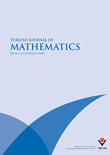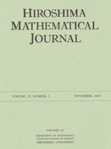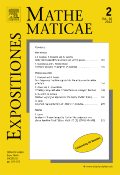
Turkish Journal of Mathematics
Scope & Guideline
Exploring the Depths of Mathematical Knowledge
Introduction
Aims and Scopes
- Pure Mathematics:
This includes areas such as algebra, topology, number theory, and geometry, where researchers explore abstract concepts and theoretical frameworks. - Applied Mathematics:
The journal features studies that apply mathematical theories and techniques to real-world problems, including mathematical modeling, statistics, and computational methods. - Differential Equations:
A significant number of publications are dedicated to the analysis of ordinary and partial differential equations, including their solutions, stability, and applications. - Algebraic Structures:
Research on algebraic systems such as groups, rings, and semigroups, with a focus on their properties and interrelations, is prominently featured. - Numerical Methods:
The journal emphasizes the development and analysis of numerical techniques for solving mathematical problems, particularly those arising in applied contexts. - Geometric Analysis:
The exploration of geometric structures and their mathematical implications, particularly in relation to Riemannian and pseudo-Riemannian manifolds, is a recurring theme. - Functional Analysis:
Studies involving function spaces, operators, and their applications in various mathematical contexts are frequently published.
Trending and Emerging
- Fractional Calculus:
Research in fractional calculus is on the rise, showcasing its applications in various fields, such as physics and engineering, and its relevance to both theoretical and applied mathematics. - Nonlinear Dynamics and Chaos Theory:
An increasing number of papers focus on nonlinear dynamics, indicating a growing interest in chaotic systems and their mathematical modeling. - Mathematical Biology:
The intersection of mathematics and biology is gaining traction, with studies modeling biological systems and phenomena, which reflects a broader trend in interdisciplinary research. - Computational Mathematics:
There is a notable increase in research related to computational methods, algorithms, and numerical analysis, emphasizing the need for efficient and effective solutions to complex mathematical problems. - Topology and Its Applications:
Recent publications indicate a resurgence in interest in topology, particularly its applications in other fields such as data analysis and robotics. - Mathematical Optimization:
Research focusing on optimization techniques and their applications is emerging as a significant theme, reflecting the demand for efficient solutions in various sectors.
Declining or Waning
- Classical Geometry:
Research on classical geometric problems, which once constituted a significant portion of the journal's contributions, appears to be waning, potentially due to the rise of computational and applied approaches. - Elementary Number Theory:
While still relevant, the frequency of publications on elementary number theory has decreased, possibly as researchers explore more complex and applied aspects of number theory. - Basic Combinatorial Techniques:
The exploration of fundamental combinatorial topics seems to be less prominent, as more sophisticated combinatorial theories and applications gain attention. - Traditional Algebraic Methods:
There is a noticeable reduction in papers focusing on traditional algebraic methods in favor of more modern algebraic structures and their applications.
Similar Journals

Advanced Studies-Euro-Tbilisi Mathematical Journal
Connecting Global Minds in Mathematical ExplorationAdvanced Studies-Euro-Tbilisi Mathematical Journal, published by the esteemed TBILISI CENTRE MATH SCI, is a vital resource for scholars and practitioners in the field of mathematics. Since its inception in 2021, this journal has committed to advancing knowledge across various mathematical disciplines, including Algebra and Number Theory, Analysis, Applied Mathematics, and Geometry and Topology, although it currently holds a category quartile ranking of Q4 in all these areas. With an open-access format, it provides unparalleled access to cutting-edge research to a global audience of researchers, professionals, and students, fostering collaboration and innovation within the mathematical community. Operating from TBILISI, Georgia, the journal acknowledges the growing importance of diverse geographical contributions to mathematics and aims to spotlight emerging research trends. As research continues to evolve, Advanced Studies-Euro-Tbilisi Mathematical Journal seeks to enrich the academic dialogue and support the dissemination of mathematical knowledge.

BOLETIN DE LA SOCIEDAD MATEMATICA MEXICANA
Pioneering Insights in Diverse Mathematical FieldsBOLETIN DE LA SOCIEDAD MATEMATICA MEXICANA, published by Springer International Publishing AG, is a pivotal journal in the field of mathematics, particularly recognized for its contributions to the miscellaneous mathematics category, holding a commendable Q2 ranking as of 2023. With an ISSN of 1405-213X and an E-ISSN of 2296-4495, the journal serves as a platform for disseminating high-quality research and innovations from both national and international scholars. Operating from Switzerland, the journal encompasses a broad range of topics within mathematics, supporting the development and communication of mathematical knowledge. Although it is not open access, it remains a respected source for researchers, professionals, and students seeking to deepen their understanding of mathematical concepts and applications. Published continuously and rigorously since its converged years, BOLETIN DE LA SOCIEDAD MATEMATICA MEXICANA plays a crucial role in advancing mathematical discourse and collaboration across disciplines.

Bulletin of the Iranian Mathematical Society
Empowering researchers to share groundbreaking mathematical insights.The Bulletin of the Iranian Mathematical Society, published by SPRINGER SINGAPORE PTE LTD, is a distinguished journal dedicated to advancing the field of mathematics. With an ISSN of 1017-060X and E-ISSN 1735-8515, this journal has established a valuable platform for researchers and scholars to disseminate their findings from 2008 to 2024. The journal is categorized in the Q2 tier of Mathematics (miscellaneous) for 2023, showcasing its importance and relevance in the mathematical community, ranked #169 out of 399 in General Mathematics with a 57th percentile standing in Scopus. While currently operating under a subscription model, it remains an essential resource for professionals and students seeking cutting-edge research and developments in various domains of mathematics. The Bulletin aims to bridge theoretical research and practical application, thereby enriching both academia and industry.

INDIAN JOURNAL OF PURE & APPLIED MATHEMATICS
Advancing Mathematical Frontiers Since 1996INDIAN JOURNAL OF PURE & APPLIED MATHEMATICS, published by the INDIAN NATIONAL SCIENCE ACADEMY, stands as a vital resource in the realm of pure and applied mathematics since its inception in 1996. With ISSN 0019-5588 and E-ISSN 0975-7465, this journal aims to disseminate original research that advances the understanding and application of mathematical principles. Operating out of New Delhi, India, it serves a diverse readership comprising researchers, scholars, and practitioners in the mathematical sciences. Recognized within the Q3 category in both Applied Mathematics and Miscellaneous Mathematics as per the 2023 category quartiles, the journal emphasizes rigorous peer-reviewed articles that contribute to its impact in academia, reflected in its Scopus rankings. Although it does not currently operate as an open-access journal, it maintains a commitment to quality and accessibility of scholarly content, striving to foster academic collaboration and innovation. The convergence of full-text issues from 1996 to 2024 highlights its ongoing dedication to the evolution of mathematical research.

RENDICONTI DEL SEMINARIO MATEMATICO DELLA UNIVERSITA DI PADOVA
Exploring the frontiers of mathematics with open access insights.RENDICONTI DEL SEMINARIO MATEMATICO DELLA UNIVERSITA DI PADOVA, published by the European Mathematical Society, stands as a notable open-access journal with a rich history in disseminating research across various domains of mathematics. With an ISSN of 0041-8994 and E-ISSN 2240-2926, this journal has embraced open access since 2023, significantly enhancing its visibility and accessibility to a global audience. Situated in Germany, its publishing house is based at Technical University Berlin, which emphasizes its academic roots and dedication to fostering mathematical research. The journal features a quartile ranking of Q3 across multiple categories including Algebra and Number Theory, Analysis, Geometry and Topology, and Mathematical Physics as of 2023, indicating a vibrant contribution to the field, despite its challenge in specific rankings. Researchers, professionals, and students alike will find in this journal a platform for innovative ideas and significant findings that are crucial to the evolution of modern mathematics.

Revista de la Real Academia de Ciencias Exactas Fisicas y Naturales Serie A-Matematicas
Advancing Mathematical Frontiers with ExcellenceRevista de la Real Academia de Ciencias Exactas Fisicas y Naturales Serie A-Matematicas, published by SPRINGER-VERLAG ITALIA SRL, is a premier academic journal based in Italy that serves as a significant platform for researchers and practitioners in the fields of Mathematics. With a focus on core areas such as Algebra, Analysis, Applied Mathematics, Computational Mathematics, and Geometry and Topology, this journal boasts an impressive performance in academic rankings, achieving Q1 status in multiple categories, reflecting its excellence in disseminating high-quality research. The journal is easily accessible through subscription options and provides a vital resource for the mathematics community, fostering the exploration of innovative ideas and methodologies. The journal’s commitment to advancing mathematical knowledge is evident through its competitive Scopus rankings, including a remarkable rank of #1 in Algebra and Number Theory, placing it in the top percentile of its field. Scholars and students alike will find in this publication a rich source of impactful research that not only contributes to the academic discourse but also enhances the practical applications of mathematics in today's society.

Journal of Mathematical Study
Bridging Theory and Practice in MathematicsJournal of Mathematical Study, published by GLOBAL SCIENCE PRESS, stands as a prominent platform dedicated to advancing knowledge in the field of mathematics. With ISSN 2096-9856 and E-ISSN 2617-8702, this journal aims to disseminate high-quality research articles, reviews, and theoretical studies that encapsulate the latest developments and innovative methodologies within mathematical sciences. Although it is currently not open access, the journal strives to provide comprehensive insights into a spectrum of mathematical disciplines, catering to researchers, students, and professionals seeking to deepen their understanding of both pure and applied mathematics. The Journal of Mathematical Study plays a critical role in fostering scholarly communication and collaboration, making it an essential resource for anyone invested in the rapidly evolving world of mathematical research.

Frontiers of Mathematics
Innovating Research to Shape the Future of MathematicsFrontiers of Mathematics, published by SPRINGER HEIDELBERG, is an emerging academic journal dedicated to fostering the advancement of mathematical sciences from 2023 to 2024. With an ISSN of 2731-8648 and E-ISSN of 2731-8656, this journal is positioned in the category of Q2 in the miscellaneous mathematics domain, showcasing its commitment to quality research and innovation. Although in its nascent stages, it has swiftly established a foothold within the global academic landscape, holding a Scopus rank of #198/399 and a median percentile of 50, indicating a promising trajectory. By providing an open-access option, Frontiers of Mathematics ensures broad dissemination of research findings, fostering collaboration and knowledge sharing across the mathematical community. Researchers, professionals, and students alike will find this journal to be an invaluable resource, contributing to important discussions and advancements in various mathematical fields.

Hiroshima Mathematical Journal
A Legacy of Mathematical Research and DiscoveryThe Hiroshima Mathematical Journal, published by Hiroshima University, Graduate School of Science, serves as a prominent platform for disseminating high-quality research in the field of mathematics. Established in 1959, the journal has been an integral part of the mathematical community, focusing on areas such as Algebra, Number Theory, Analysis, and Geometry and Topology. Although currently classified in Q4 quartile rankings within its categories, the journal is committed to advancing mathematical knowledge and fostering scholarly dialogue. Its accessibility, combined with its long-standing history, makes it an essential resource for researchers, professionals, and students dedicated to exploring and enhancing the mathematical sciences. For those interested in contributing or accessing cutting-edge research, the Hiroshima Mathematical Journal continues to uphold its mission of excellence in mathematical scholarship.

EXPOSITIONES MATHEMATICAE
Fostering Original Research in Diverse Mathematical FieldsEXPOSITIONES MATHEMATICAE, published by Elsevier GmbH, stands as a significant journal in the realm of mathematics, catering primarily to researchers, professionals, and students. With an ISSN of 0723-0869 and an E-ISSN of 1878-0792, this journal has made its mark in the academic community, boasting a Q2 classification in the miscellaneous mathematics category for 2023, illustrating its prominence within its field. The journal addresses a diverse scope of mathematical topics, encouraging the publication of original research and innovative theories while maintaining rigorous academic standards. As it converges from 2004 to 2024, EXPOSITIONES MATHEMATICAE continues to be an essential resource for advancing mathematical knowledge and fostering scholarly communication, despite being a non-open-access publication. Its location in Munich, Germany further anchors it within a rich intellectual tradition, providing accessibility for the mathematical community worldwide.